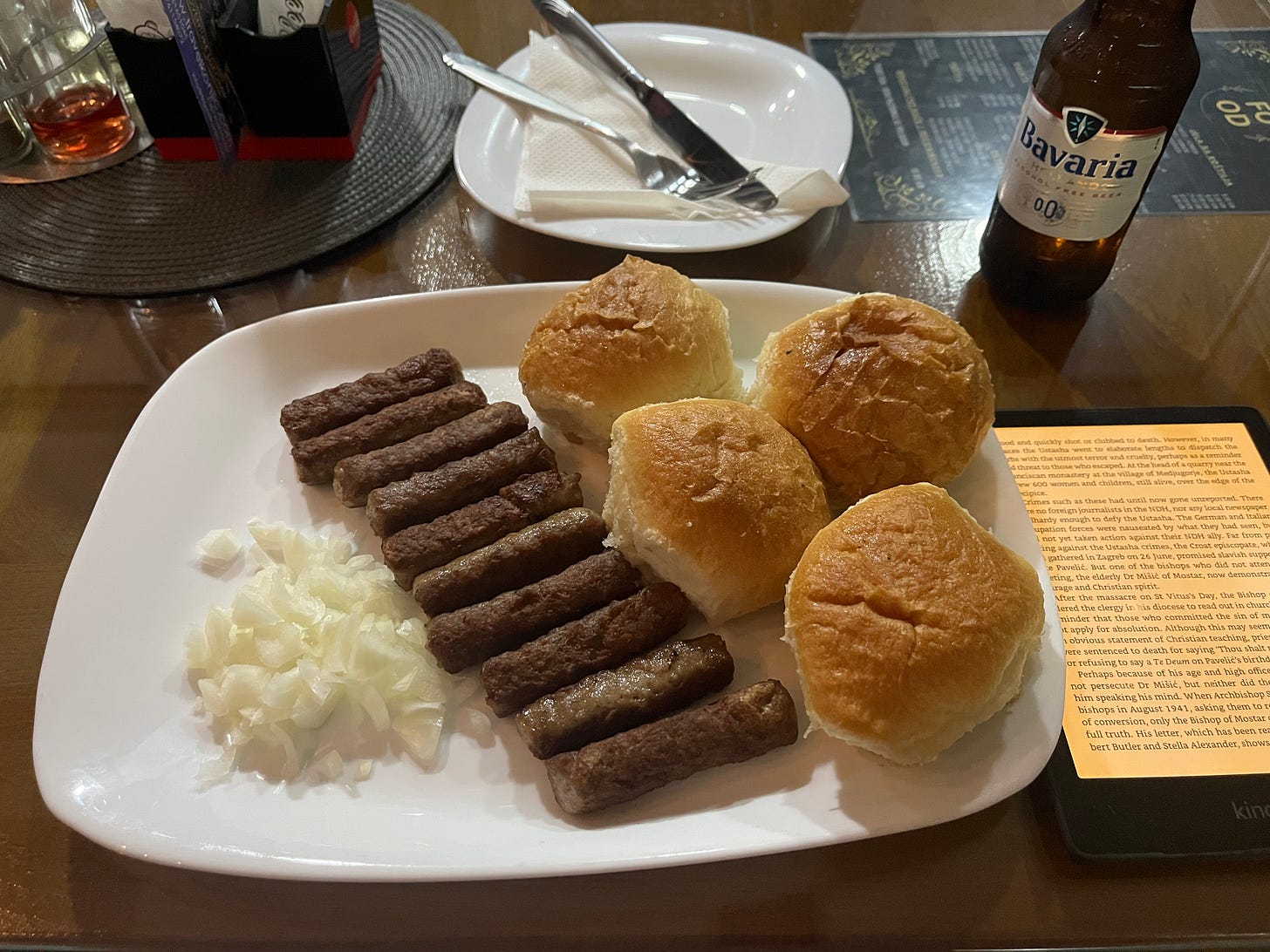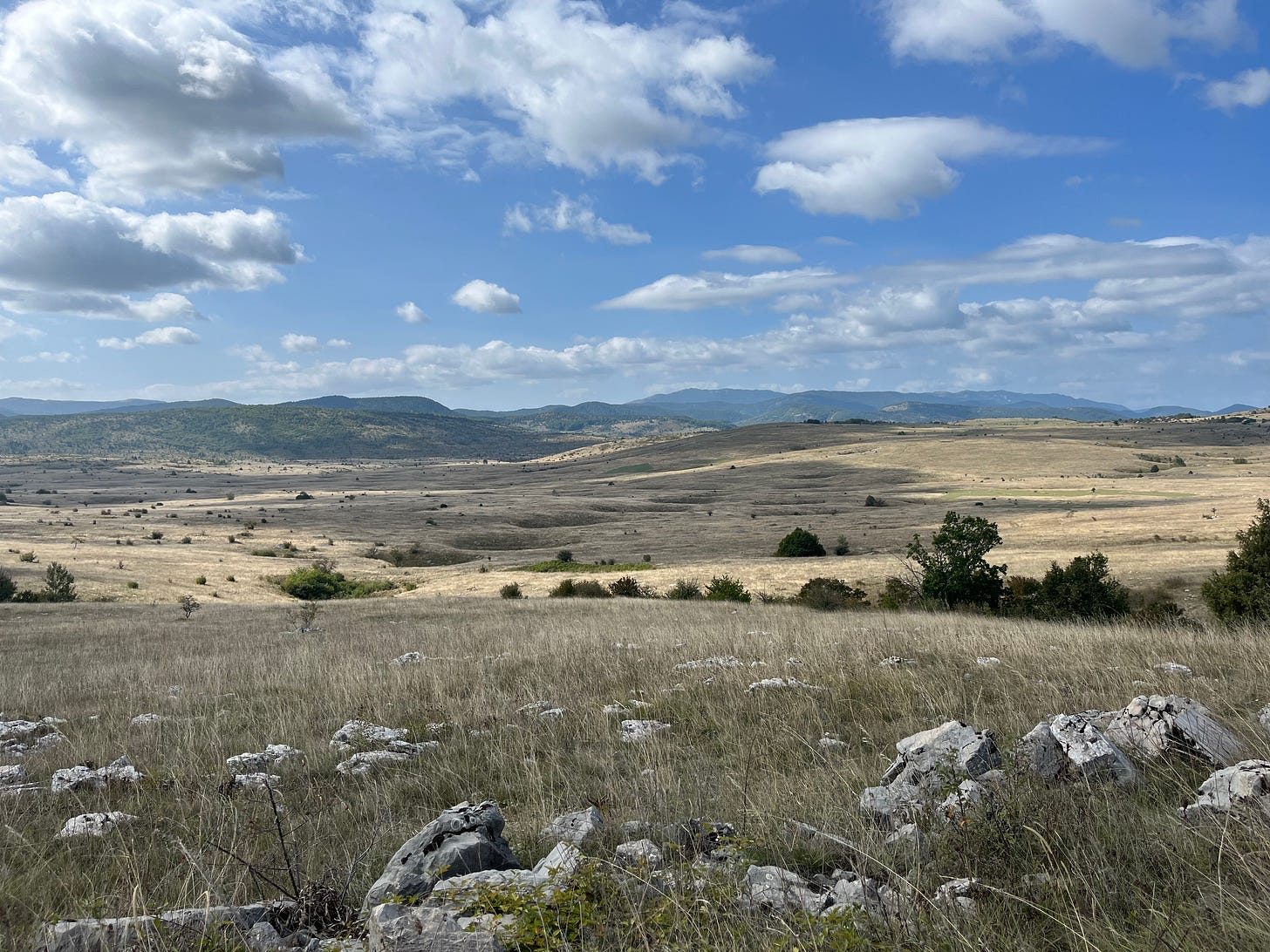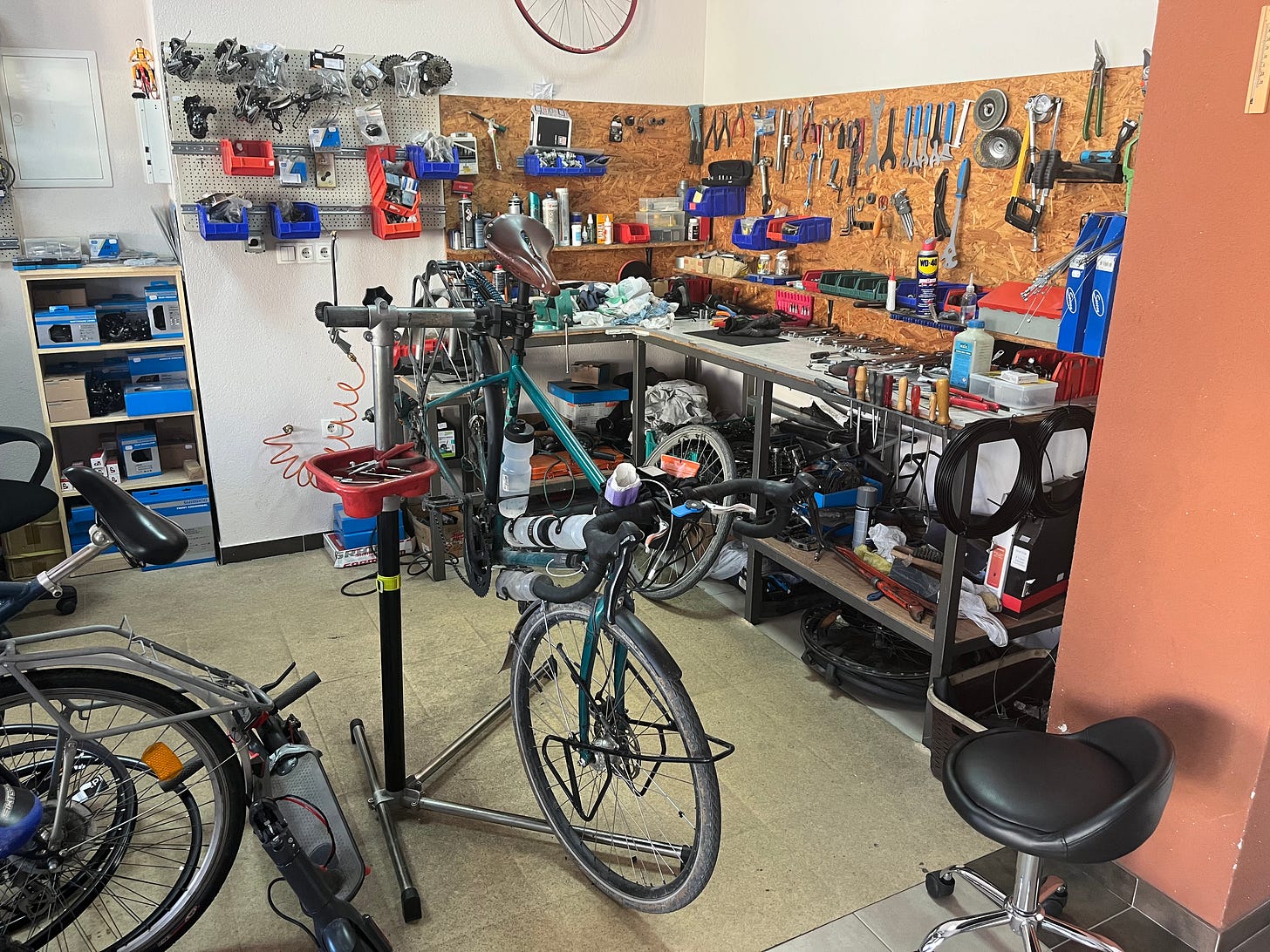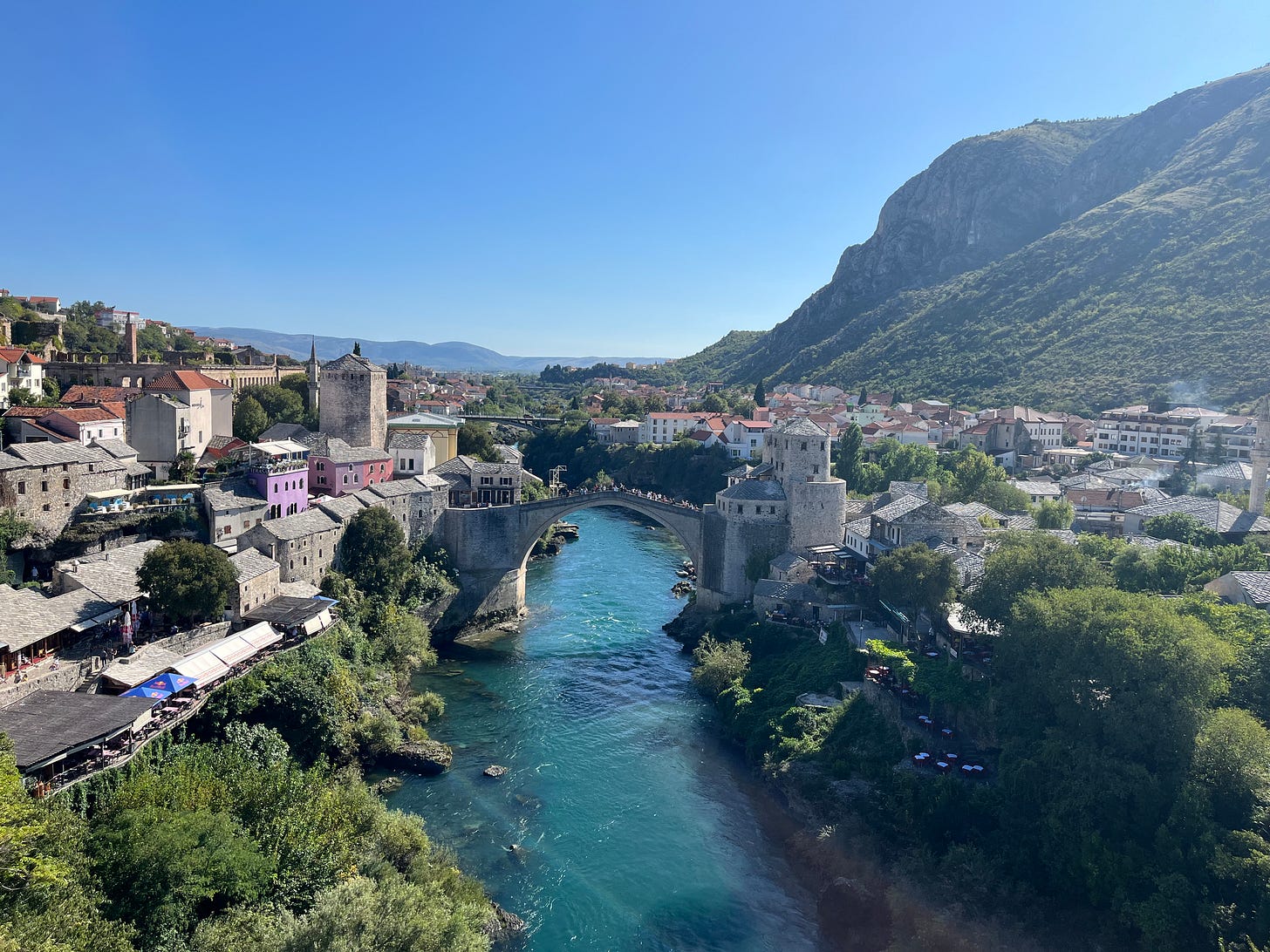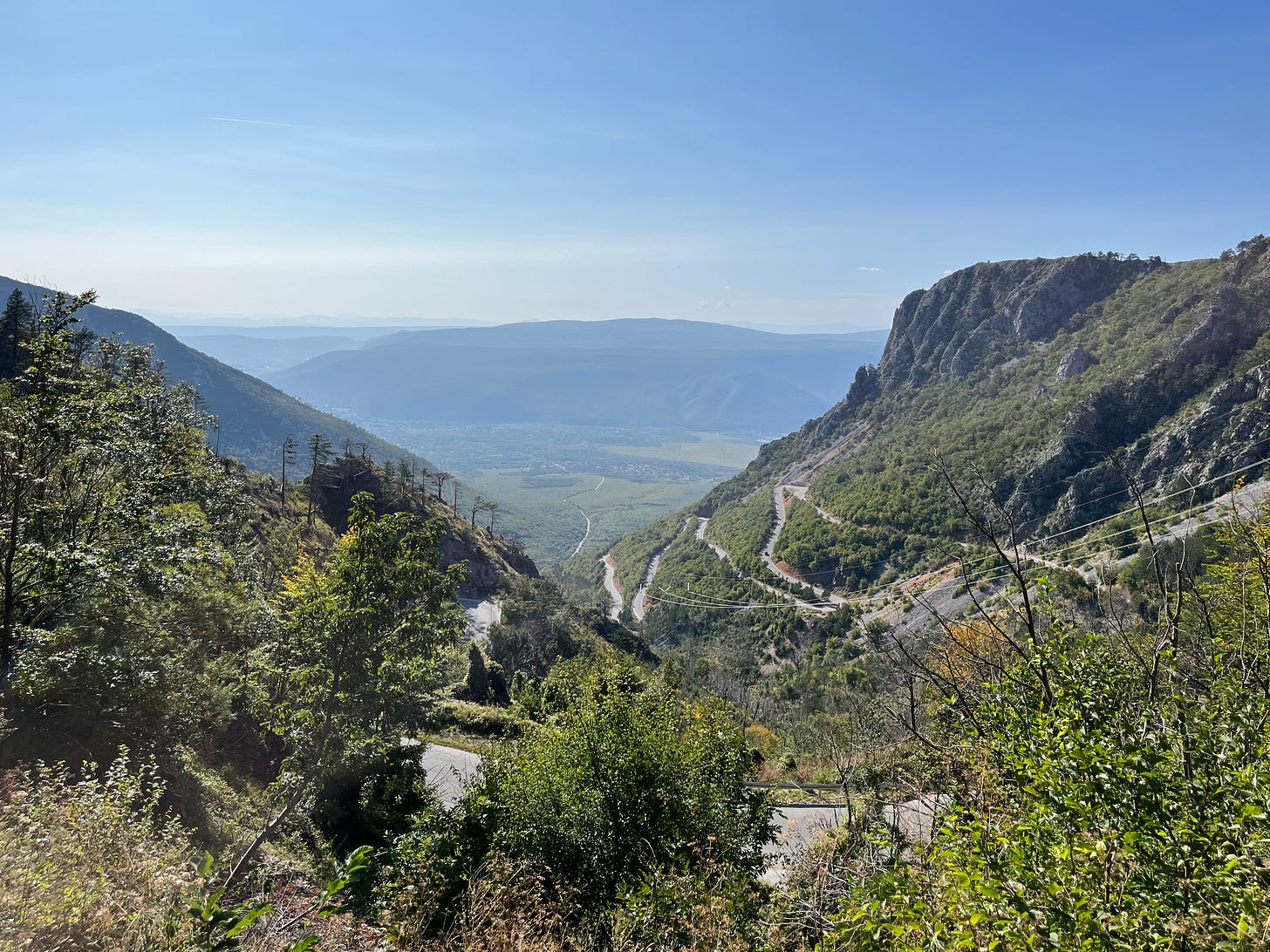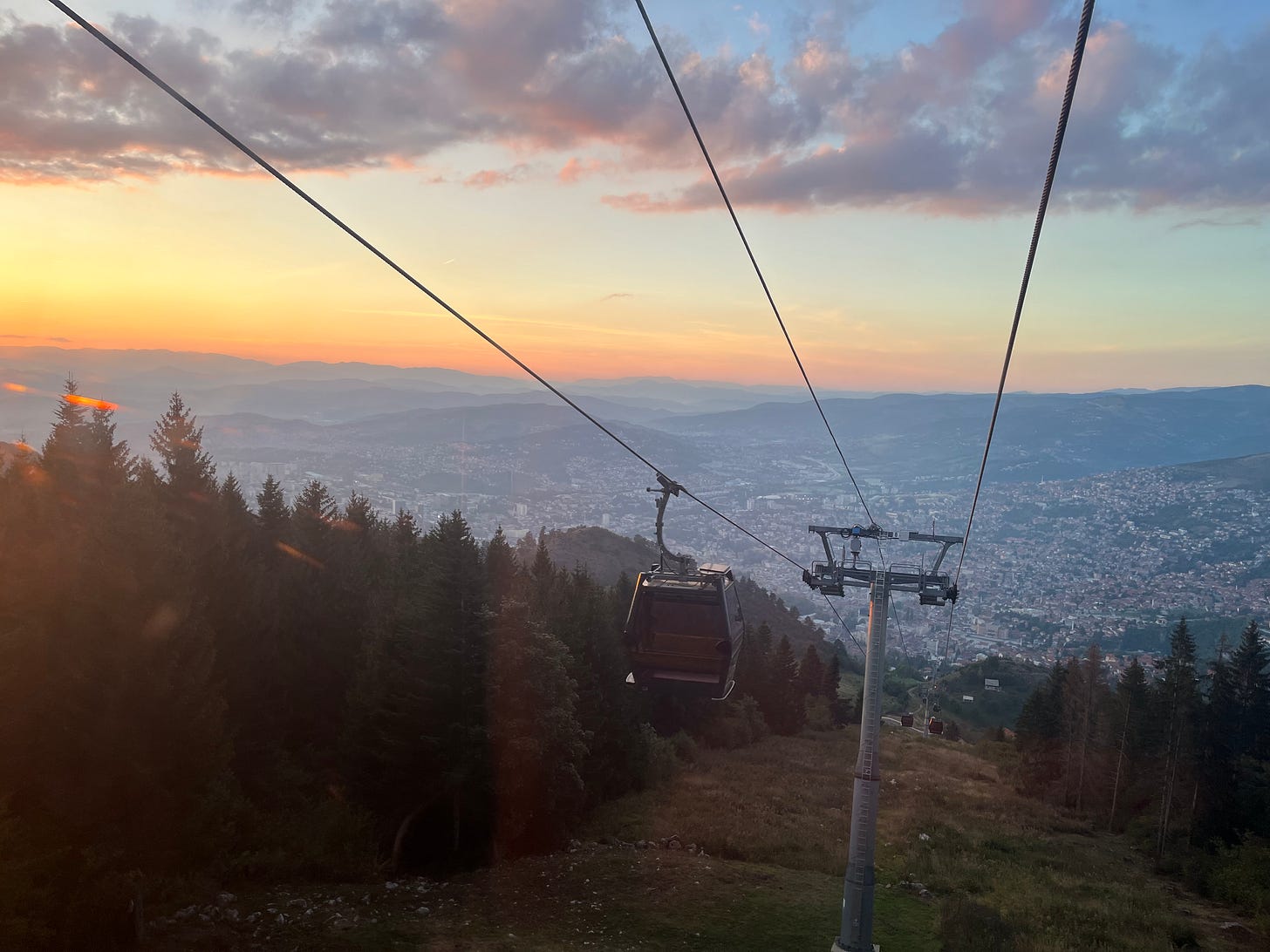#155 | War and optimism
Sarajevo, Bosnia-Hercegovina
Miep Gies was one of the Dutch citizens who hid Anne Frank. Gies, who died at 100, said: “I certainly think that another Holocaust can happen again. It did already occur; think of Cambodia, Rwanda, and Bosnia.” Of the four genocides Gies mentions, I know nothing of Bosnia or Cambodia. I learned about the Holocaust at school and visited the Memorial to the Murdered Jews of Europe in Berlin last year. I visited Rwanda two years ago and visited the Genocide Museum in Kigali. The museum shook me. Afterwards, I saw Rwanda in a darker, gloomier light. The police on street corners, which I had passed before, were more prominent — more omniscient. But as I crossed Bosnia-Hercegovina last week, I was ignorant of the conflict that recently happened here. What even did happen? And what are the perspectives of Bosnians? How, too, can we discover a country when travelling at the speed of a bicycle? These are all the questions have I set out to answer. But today is not a history lesson1: I am not a historian, I do not wear tweed. If I tried to tell you facts, I would get them wrong. I’d get them wrong because the conflict and crimes committed were so complex, convoluted, and terrifying that the threads are almost impossible to tie together. I can, however, share some impressions from the saddle.
Today I write from Kawa Cafe in Sarajevo. Dobar dan! I wrote last week: ‘As I cycle, I’m increasingly aware that I have no idea about the places I am visiting. … only by living somewhere for a long time can you know a place.’ What I wrote was wrong. You can get to know a place by making an effort. If you were learning about the UK, you’d read the Times and the Guardian; you’d go to The Bird in Hand and have a pint — perhaps you’d play pool with Craig and Dave. You’d visit the little Ethiopian place on Dalston Road that feeds you for £8.50, is BYOB, and only takes cash; you’d sit on Brighton Pier dripping fish-and-chip vinegar on your trousers. You’d take a pill at Carnival. You might walk the North Coast 500, looping Scotland, and run the Manchester Half. You would read the biographies of Thatcher, Churchill, Disraeli, Sturgeon, and Pitt; you’d read Pride and Prejudice, Harry Potter and Tom Brown’s School Days. If you did all that, you would meet people on the way who’d fill in the blanks of some essential Britishness uncaptured in Lonely Planet. This would take time, but some Carling-fuelled, Walkers-crisps, centre-right Britain would emerge.
In the same way, this week, I have made an effort to learn about Bosnia-Hercegovina. I have eaten ćevapčići every day; I have tasted Bosnian coffee and dipped the sugar cube; I’ve eaten from countless roadside stalls.
But it’s not all joyous — instead, it’s shifted my perspective of the glorious mountains. Under blue skies, I left the River Una, stopping in a peaceful campsite, refusing grappa, accepting an open fire. I headed past Livno and peddled east towards the Blidinje National Park. The ground is beginning to get arid, rockier, and less cosy. My tent pegs strain as I bury them in the heavy lime soil. Near Livno, my spoke broke, so I took a detour to Tomislavgrad, 30 km away, to get it fixed. Rather than taking the main road (which is increasingly hectic and requires high-vis and a helmet), I took a steep, rough track, where every bounce gave me ‘spoke anxiety.’ Will more go? I’m totally screwed if this wheel bends! I kept reminding myself of the remarkable view to my west: the dry beige grass on undulating hills.
I got to Tomislavgrad carrying my new 3ft wooden spoon, bungeed to my panniers, to wave off those rabid dogs which snap at my Achilles. The mechanic’s friend Rob and I spoke while my bike was fixed. I was surprised to hear that there are three presidents2 of Bosnia-Herzegovina. In this Swiss-style system, power rotates every eight months. It’s impossible to agree, and it sounds designed for gridlock. Rob tells me it’s unsustainable — “our country is like an arranged marriage; we’re forced together, and it won’t last for a decade… I hope there won’t be another war”. Aside from the fact that there had been a war, I was ignorant of details. One friend commented that “there is always fighting in the region”; but why? and between whom? I found some books3 and opened my mind to understand what was happening.
After a couple more days of cycling, I rolled into Mostar. I descended at sunset into the Neretva Canyon. As I crossed the town, I noticed the minarets of the mosques, which, in concert, began a call to prayer. I am moving east, and the influence of the Ottoman Empire, which spread Islam across the Balkans, is apparent and essential when understanding the nature of the last century. (I’m looking forward to the mosques of Istanbul). In Mostar, I stayed with Majda, whose hostel is tranquil; it’s the first time I’ve hung out with travellers, people on their gap years, lots of Aussies, Never Have I Ever, et cetera. Who is the dude in the corner with the book and tea, they ask? It’s me! Majda tells me she lived in Harrow during the war but returned as London didn’t feel home to her. The town straddles the Neretva River, crossed by various modern bridges, or over the famous ‘Stari Most’ (Old Bridge). The Ottomans built this immense stone bridge in the sixteenth century. I had a paradisial view of the town after climbing two hundred steps in the Nesuh-Aga Vucjakovic Mosque, constructed shortly before 1554.
Yet the most striking moment of the week, the most heartbreaking, and the most pertinent moment of this essay, then followed. I walked into the Genocide and War Museum, in the old town, expecting an archaic, stuffy museum, irrelevant and distant to my life. It’s what the word ‘museum’ conjures. What I saw stunned me. The three-floor tour showed me human-inflicted hell from ’92 - ’95. Because of its recency, the conflict was often filmed. There were films of a Muslim man being forced at gunpoint to pretend he was with UN workers, to tempt his son out of hiding — both were subsequently executed. The bridge I walked over earlier, the Stari Most, was destroyed by mortar, and the perpetrators filmed it: “Just one more, she’s nearly down”. Likewise, although ostensibly historic, the mosque I visited was rebuilt in 2010; it’s not two decades old. Weapons and torture devices were screwed to the walls, with labels describing how this bat, or that chain, or these barbed wire handcuffs were used on civilians in concentration camps. Storyboards mapped out the UN’s response and neglect; they failed to secure a safe zone that was eventually handed over to a genocidal force which executed eight thousand men, women and children.
Leaving Mostar, I felt depressed and sad. Despite all of the caffeine and intermittent sugar stops, I couldn’t shake the gloom. Even Sam Harris talking to Donald Hoffman about how our reality is virtual reality could not lift my spirits: Everything is an illusion, yet there I am on an illusory bicycle feeling terrible. I will not go into detail about the conflict. Wikipedia provides an excellent summary (I’ve included some pertinent points in the footnotes).
The road from Mostar was a relentless climb from the Neretva River basin over the mountains Tito hid among when he formed The Socialist Federal Republic of Yugoslavia. I had time to sweat and reflect. On the other side of these mountains, Sarajevo sits in its soviet-era majesty. On the road, the Volkswagen Polos I’d seen in the museum’s videos still seemed to cross red lights, all boxy and manic. The houses I’d seen in the videotapes, where murdered families had been burned, still sat charred and empty and full of bullet holes. In one house with fire damage and no windows or doors, a family had moved in but had no money to re-fit the building. In the villages I inched through, I noticed several people with missing limbs (some just older than me; were they injured as children?) The conflict appeared absurdly recent, and the scars — which I was blind to before — were now everywhere.
The following day Dino, born in ’95, showed me Tito’s secret nuclear bunker. I could have a frank conversation with him about the conflict. He told me his school education didn’t teach him about the war. But there is a powerful national consciousness to recover and a sense of collective rebuilding. The conversation settled me. Although there was an undeniable and tragic rift, the societal scars were healing. For example, his father (who had fought for the Bosnian Army) now went for coffee with his prior “enemy”.
We must understand religion to understand the violence that still marks the country’s buildings, bodies and conscience. ‘Anyone who approaches the Yugoslavs without some knowledge of their religious history is like a chicken trying to understand a ladder, as the Spanish proverb goes,’ writes Richard West, the historian and biographer of Tito. Despite what we might read in The Sunday Times, West continues, ‘there is no ‘ethnic difference’ between the warring factions in Bosnia-Hercegovina, all of whom are alike in blood, appearance, language and bellicose nature. All that divides them is their ancestral religion, so that the Greek Orthodox call themselves Serbs, the Roman Catholics call themselves Croats, while the unhappy Muslims, who used to describe themselves as Yugoslavs or Bosnians, are now known by a faith in which many of them do not believe. … Many [political commentators] either ignore or discount the influence on the human heart of history, myth and religion.’ It’s hard to picture the warped complexity of the social fabric which ruptures in genocide.
I spent this morning with Ahmed, a guide, walking Sarajevo. I was one of the twenty tourists attendant to the Free Walking Tour. He had a clipboard, headset and black Metallica t-shirt.
We passed the original Ottoman centre of the city, the Orthodox cathedral, and Austro-Hungarian architecture, straight from Vienna. We walk by the corner where Franz Ferdinand and his wife were shot. This place, we are reminded, was the ‘trigger’ of the First World War. Next to the replica car, through his microphone, Ahmed explains how the First World War was, in some senses, inevitable. Were it not for this assassination, the deck of cards will have collapsed the following week. The situation was stacked towards World War; layers of intricate peace treaties would pull nations into war.
When we see at a region like the Balkans, it can seem like the deck has been stacked to make conflict is inevitable: it was caught between eastern and western empires; its future was dictated by the ‘Great Powers’, and now it’s reached a period of stability, albeit in a fragmented state with ancestral differences. The Bosnian War was a modern war; the scars are healing. Even so, it’s inspirational to meet people in our generation who passionately educate tourists and fellow Bosnians about the conflict. Their optimism is overpowering, and I subscribe to the world-view that conflict is not inevitable, even if it is sometimes likely. The education of the ignorant — of people like me — will help to prevent a resurgent violent spiral.
*
Live well,
Hector
I have intentionally not included a summary of the conflict in this email because I would get it wrong. It becomes more confusing because there was a further regional conflict prior to the formation of Yugoslavia, where the minority groups fought in a different constellation. In particular, in 1941 “The Ustaše regime [Roman Catholic Croats] pursued a genocidal policy against the Serbs (who were Eastern Orthodox Christians), Jews and Romani.” Regarding he most recent 1992-95 conflict, the pertinent points from the wikipedia are as follows
The war was part of the breakup of Yugoslavia. …
1991, the multi-ethnic Socialist Republic of Bosnia and Herzegovina – which was inhabited by mainly Muslim Bosniaks (44%), Orthodox Serbs (32.5%) and Catholic Croats (17%) – passed a referendum for independence on 29 February 1992. [These are the three main ethnic groups party to the conflict] …
The Bosnian Serbs boycotted the referendum, and rejected its outcome. …
The conflict was initially between Yugoslav Army units in Bosnia [the Bosnian Serb Army] … on the one side, and the Army of the Republic of Bosnia and Herzegovina (ARBiH), largely composed of Bosniaks, and the Croat forces in the Croatian Defence Council (HVO) on the other side. …
[However, t]ensions between Croats and Bosniaks increased throughout late 1992, resulting in the escalation of the Croat–Bosniak War in early 1993 [It is often referred to as a “war within a war” because it was part of the larger Bosnian war].[15]
The Bosnian war was characterised by bitter fighting, indiscriminate shelling of cities and towns, ethnic cleansing, and systematic mass rape, mainly perpetrated by Serb,[16] and to a lesser extent, Croat[17] and Bosniak[18] forces. [This was shown, without restraint, in the museum I visited].
Estimates suggest around 100,000 people were killed during the war.[23][24][25] Over 2.2 million people were displaced,[26] making it, at the time, the most devastating conflict in Europe since the end of World War II.[27][28] In addition, an estimated 12,000–50,000 women were raped, mainly carried out by Serb forces, with most of the victims being Bosniak women.
“Although the unsubdivided body is the collective head of state, one member is designated as chairperson. The position of chairperson rotates twice around the three members every eight months, with the candidate receiving the most votes overall becoming the first chairperson over the four-year term.”
Books I’m reading about the region are as follows. The biography of Tito is especially good.


